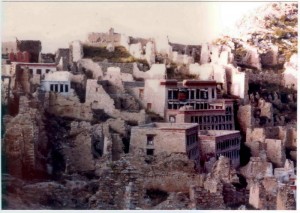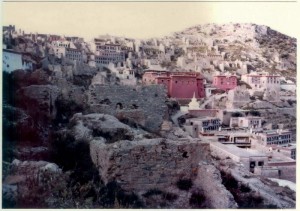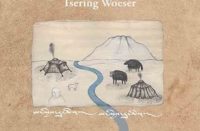High Peaks Pure Earth has translated a blogpost by Woeser written on June 17, 2011 for the Tibetan service of Radio Free Asia and posted on her blog on June 26, 2011.
In this blogpost, Woeser writes about the destruction of Ganden Monastery. The photos taken by her Father that Woeser refers to were compiled into an impressive book published in Taiwan by Locus Publishing in 2006 as “Forbidden Memory: Tibet During the Cultural Revolution”. Although there is no English translation of the publication, it has been published in Japanese and Tibetan.


When thinking about the Cultural Revolution, the scenes of Ganden Monastery laying in ruins are still vivid in our minds. For the past years, local people have been falsely identified as the culprits responsible for this. A few years ago, in order to gain an understanding of what really happened in Tibet during the Cultural Revolution, I took some photos that my Father had taken of wrecked monasteries, portraying the “forces of evil”, and went to visit over 70 elderly people who had been deprived of their youth by the Cultural Revolution. Only after I listened carefully to their unbelievable stories and experiences, did I start to fully understand the actual facts.
A Tibetan Red Guard who went to Beijing to meet the “Great Chairman Mao” and who knew to what extent Ganden Monastery had been damaged, said: “before Ganden Monastery was wrecked, it was used as storage for foodstuffs for all Lhasa Work Units and was guarded by armed forces. Later on, after the National Purchasing Department had collected all silver and gold valuables, the Army simply smashed the Buddhist statues. The soldiers tied a rope around the statues’ necks and pulled them over; they took gold, silver, copper and other metals, stored them away in vehicles and drove off. So what was left of it in the end? Only wooden parts, which were also taken away by people from Taktse County, Lhundrup County, Meldro Gungkar County, and Toelung Dechen County. Some locals living at the foot of the mountain also went to take some of the things that were left behind and these people were finally blamed for the entire destruction of Ganden Monastery.”
The greater the secrets and hidden details, the more facts are required to uncover the truth. I found an internal document from 1985, an investigative report compiled by the Autonomous Region and the Tibet Military Alliance about the mistakes that were perpetrated by the Army during the Cultural Revolution. It included the following record: “The world-famous national protection-site, Ganden Monastery, was unexpectedly destroyed and deprived of its cultural relics after the establishment of the Revolutionary Committee, which represented an irretrievable political loss. Until today, investigations into this matter have not shown any results, the research trail goes dead with Lhasa’s past military sub-district’s senior official Zhi Zuo.”
But why does the trail go dead? What did the army do that must not be exposed? Of course, it is yet another dubious case and Tibetans can do nothing but suffer in silence.
After the Cultural Revolution, many Tibetans took the spontaneous initiative to restore Ganden Monastery. The Tibetan Red Guard I interviewed said: “(…) there were some people with handcarts who could normally earn 15 Yuan per day but they refused this payment and instead worked for 2.5 Yuan per day helping to restore Ganden Monastery. There were others who earnestly and honestly offered their labour for free. Again, others donated all their savings. Most monasteries had to rely on generous donations from Tibetans in order to be revived and restored. Only when the state felt embarrassed did it generate some minor funds but then wantonly propagated it, which made it look like the restoration was carried out by the state.”
On the internet we find a report by a journalist from official state media, introducing how Ganden Monastery was revived; it states that “due to the chaos of war, natural disaster, and ‘ten years of Cultural Revolution’, Ganden Monastery was heavily damaged. (…) After 1978, the country carried out large-scale restoration work. The monastery’s monks also raised resources themselves to support the maintenance work.” The report also lists the exact numbers of the different kinds of funds that the local authorities invested in the restoration project.
It sounded as though the damage inflicted upon the monastery was an inevitable scenario and that the so-called “state” has always been a tremendously generous benefactor. But in “Old Tibet”, before ruthless liberation, there existed more than 6000 monasteries in the whole of the Tibetan areas and then, after numerous revolutions, only about 10 of them were left. Although today, most of them have been restored, their scope cannot at all be compared to the ones in the past. It needs to be remembered that the restoration efforts by the “state” have been lacking far behind the efforts of the Tibetan people. Every time a monastery was plundered, during its rebirth, Tibetan people devoted a pious confession of sweat and tears and engraved this piece of land, including its living beings and the six relams of transmigration with a spirit of resistance against treacherous powers.
June 17, 2011





Follow Us!